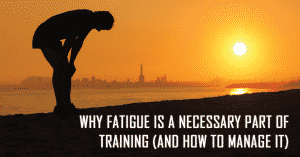As a runner, one of the most difficult concepts to understand is the idea that individual workouts do not occur in isolation of one another.
The reality is that every workout is influenced by a myriad of factors and, more importantly, a singular workout can impact your upcoming runs for as many as ten days after it’s finished.
Understanding the concept that training or an individual workout doesn’t occur in a vacuum or in isolation is essential to staying healthy long-term, avoiding overtraining, and performing optimally.
In this article, we’ll explore 3 common situations where runners typically forget this principle and how it can impact your training progress.
How running too hard leads to injury
Perhaps it’s easiest to start with an example situation you’ve no doubt experienced.
You have a VO2max or speed session scheduled for today and you’re feeling great. You hit the track and crush the workout – running each repeat much faster than your prescribed pace and you still felt strong. Great news, right?
Not so fast (pun intended).
While you no doubt accomplished the objective of the workout and running fast didn’t change the primary energy system you wanted to target, like running too fast on a tempo run would, it’s possible you’re placing more strain and fatigue on your body than anticipated, which could result in injury.
The tricky thing with running is that injuries don’t occur instantaneously.
Training would be much simpler if injuries and overtraining appeared as a direct result or immediately after a specific workout. Unfortunately, injuries and overtraining typically occur as the result of many seemingly minor factors.
It’s the proverbial “straw that broke the camel’s back” idiom applied to training.
In this specific case, metabolically speaking, running faster was within your ability. However, we know that the structural system (muscles, tendons, ligaments and bones) often lag behind your fitness. As a result, running faster might have stressed muscles in your hips or feet that weren’t strong enough yet to support such intense paces.
Consequently, you’re going to need more recovery.
That might mean shortening your next easy run, scheduling an extra day off, or pushing back your next workout. However, if you’re like most runners I know, this won’t happen.
While you might get away with ignoring the long-term stress of one workout occasionally, it’s only a matter of time before it catches up with you.
Shuffling workouts
Similarly, you need to be cautious when moving scheduled workouts around to accommodate work, travel or family. While these situations are often unavoidable, it’s important to consider how moving a workout impacts recovery and how you’ll feel during subsequent runs or workouts.
- The body operates in a purely physiological environment and it doesn’t recover faster simply because we need to run our long run a day earlier.
- Likewise, as much as we wish it did, the body doesn’t adhere to our concept of a week. Just because your training week ends on a Sunday, it doesn’t mean you start fresh on Monday. The miles and workouts are still in your legs.
While it’s difficult to provide general advice about the best way to shuffle workouts, there is one piece of advice that will always apply regardless of your situation. It’s better to be cautious and skip a hard workout in favor of rest or an easy day than to cram intense sessions too close together.
Training is like making popcorn, it’s better to be slightly undercooked than a little overcooked (click to Tweet).
Weather, stress and other outside factors
Finally, it’s important to remember that your training is affected by your entire environment and not just the workouts on your schedule.
Performing yard work after your weekend long run is going to delay your recovery compared to spending the day with your feet kicked up watching track on television.
It’s important to keep these outside stressors in mind when planning your recovery or trying to deduce why you feel more tired than expected.
Stressors like yard work or an insane day at the office are easy to identify. However, one factor most runners ignore is the impact of the heat on recovery. As summer approaches, it’s crucial to understand how your recovery is affected by hot weather.
How your recovery is affected by hot weather
As anyone who has trained in warm weather knows, a hard workout on a hot day means you’re going to have to slow down.
Okay, most runners can begrudgingly accept that. Yet, the negative impact of the heat doesn’t exist in the vacuum of that one workout. It affects your recovery for all subsequent runs.
The body recovers by delivering oxygen and nutrients to the muscles through the circulatory system – via blood.
In hot weather, the body cools itself by sending blood to the skin to be cooled by the air. As a result, there is less blood available to repair the muscles.
This process also uses energy that would otherwise be available for recovery. So, even when you’re not running, the body is spending energy to keep you cool as opposed to promoting recovery.
Therefore, running a workout in hot weather doesn’t just impact that one run. The delayed recovery impacts your subsequent workouts.
This is one of the primary reasons you always feel terrible when training in the summer.
Final thoughts
Remember that training doesn’t occur in a vacuum.
Your performance during a specific workout is affected by your schedule, the weather, and your previous workouts and runs that week.
Furthermore, the fatigue you generate carries over into your subsequent runs.
By keeping this bit of training advice in mind, you’ll be more consistent with your workouts and avoid injury and overtraining.





5 Responses
Another area of “context” that matters in your training is what you are doing in the “rest of your life” at the time as well. For example, I have a client who asked if it was OK to move his long run with MP miles to a Sunday instead of Saturday because he was moving on the Saturday. Moving can never be considered a “rest day”, or even an easy day, so it’s highly unlikely he’ll get the desired quality and gains out of Sunday’s workout. Other activities like landscaping or yard work, visiting an amusement park and spending all day on your feet, coaching youth sports, etc. can impact the quality of your workouts and should be considered when designing or evaluating training schedules and results.
Great points, Greg. It’s critical to factor in as many outside influences on your training as possible when planning your workouts.
Like your experience, I find a big struggle with many runners, especially in the summer, is heading to the beach to soak in the sun all day Saturday and then wondering why they were dehydrated and felt terrible during their long run Sunday. Training would be so much easier if we could fit our workouts in a cocoon of training 🙂
Great article, I didn’t realize that the body cooled itself by sending the blood to the skin. This may explain why I was having such a hard time a couple of weeks ago for about two weeks. It was very hot and humid here and I was just not up to par. Since it has been cooler and no humidity I’ve been feeling great and hitting all my training. Thanks for sharing.
Absolutely. Glad the article helped you realize the possible reasons for your recent struggles. I am going to dig into this topic in more depth in a couple weeks, so stay tuned.
I have been struggling with the heat in a huge way this year. I had read about blood needing to cool the skin earlier, but the rest of this article puts it all together. The hot weather has had such a major impact on my running. Thanks for the insight!